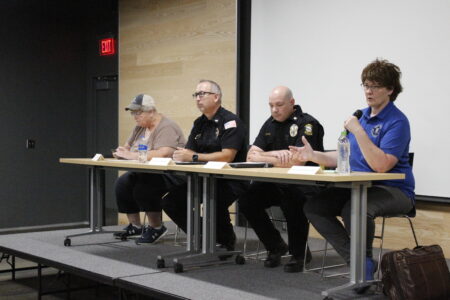Douglas County law enforcement leaders say they plan to continue collecting traffic stop data in the wake of study examining racial disparities

photo by: Austin Hornbostel/Journal-World
From right to left, Douglas County Undersheriff Stacy Simmons; John Dietz, the deputy chief of the University of Kansas Police Department; and Eudora Police Chief Wes Lovett fielded questions from members of the public during a meeting about a study examining possible racial disparities in traffic stop data Wednesday, Aug. 10, 2022 at the Lawrence Public Library. Lawrence City Commissioner Lisa Larsen, pictured on the far left, spoke on Lawrence Police Chief Rich Lockhart's behalf.
Data collection for a study on traffic stops in Douglas County may be over, but local law enforcement leaders say they won’t let that be the end of the conversation about racial bias and policing.
On Wednesday night at the Lawrence Public Library, several leaders from area law enforcement agencies fielded questions from the public about the issues in the study, and they all said they would continue collecting data on traffic stops, as well as examining the study for clues on what kinds of changes might be necessary in their departments. They said collecting the data would have a number of benefits in helping departments do their work more fairly and address problems.
“It should bring a great deal of confidence to whatever city you’re from that these kind of things can be found quickly and we can eliminate this officer or we can get them back to the best practices we use as an agency,” Eudora Police Chief Wes Lovett said. “So that’s how we’ll use the data. It makes me sleep better at night, and it should make everybody else, that we have this at our (disposal), so that somebody can’t slip through the cracks and be that guy (showing bias).”
As the Journal-World previously reported, the study examined traffic stops conducted by law enforcement agencies in Douglas County in 2020 and 2021. It found, among other things, that Black drivers were nearly three times as likely as white drivers to be pulled over for a traffic stop in Douglas County, and drivers of color were nearly twice as likely to be searched. The study was commissioned by the Douglas County Criminal Justice Coordinating Council, and researchers presented a draft of their findings earlier this month.
Leaders from three of the five law enforcement agencies involved in the study — Douglas County Undersheriff Stacy Simmons, deputy University of Kansas police chief John Dietz and Eudora’s Lovett — were at Wednesday’s discussion. Lawrence Police Chief Rich Lockhart wasn’t present, but Lawrence City Commissioner Lisa Larsen sat in and offered some prepared comments on his behalf. There was no representative present from the Baldwin City Police Department.
All of the law enforcement representatives said that participating in the study in the first place was important and has allowed law enforcement agencies in the county to collect important data they previously didn’t have at their disposal.
The conversation wasn’t all rosy, though. At one point, Simmons was discussing searches conducted on drivers of color. The study found that the percentage of drivers of color who were searched by deputies during traffic stops was 2.77 times the percentage of white drivers searched. Simmons said Black drivers are searched more often than white drivers using “an odor of marijuana” as probable cause, but that a white driver who might be a known dealer of drugs like fentanyl or other opioids wouldn’t be searched because “you can’t smell heroin.”
Some audience members said they thought that sounded like an excuse to pull over and cite drivers of color.
“We’ve got to come up with a better method for addressing all this other stuff that is causing havoc in our neighborhoods, because it’s not actually marijuana,” one audience member said.
That conversation didn’t last much longer, as the meeting was cut short because the library had closed about 10 minutes earlier.
• • •
The researchers behind the study, Northeastern University’s Jack McDevitt and American University’s Janice Iwama, also answered questions at Wednesday’s discussion. They said that at least some data from each law enforcement agency could be evidence of possible racial profiling — though they also said such instances were not widespread. When an audience member asked whether county residents should be concerned about that data, McDevitt said they should.
“No agency has got disparities for everything, but every agency has some disparities,” McDevitt said. “They all have areas they’ve got to work on.”
The researchers also presented the study to the Lawrence City Commission on Tuesday and to the Douglas County Commission at its meeting earlier on Wednesday.
County commissioners, at their meeting, asked how much more data agencies would have to collect in order to make more informed comparisons and decide whether policy changes were needed. McDevitt said that could take anywhere from six months to a year of further data collection and analysis.







